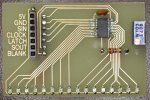Hi all,
Have a question about soldering surface mount chips. I bought two CAT4016 - 16 Channel Constant Current LED Driver chips to play with. I didn't realize however, how small these things are. The chip is a 24 pin TSSOP footprint. Actual chip measures 4mm X 8mm. I successfully made up a PCB using Diptrace and transferred it to a photo sensitive double sided PCB. The board came out great despite my trepidation about 0.01" traces!
This morning, after my coffee and some deep breathing, I dove in and actually soldered it up. Took about 45 minutes with X20 head mounted magnifier - My head was so close to the board that I could feel the heat off the soldering iron. Even my finest tip seemed huge under the magnification. I couldn't get each individual trace without some bridging and had to use my desoldering pump iron to suck away the excess. I hooked it up to an 08M, input some code and actually have the 16 LEDs strobing ! I love it when a plan comes together...
Figuring there must be an easier way, I did a google search and found this:
http://www.youtube.com/watch?v=MSIyxEUK8Fo
That chip looks to have double the spacing between pins of mine (similar to the surface mount 28X1's I have), but I'm wondering if it's actually as easy as he makes it look.
I can't say I've ever seen flux-in-a-bottle, but then again I've never really been looking for it either. Is this something that's readily available ?
I've seen the examples with the solder paste and ovens and such, but would prefer to stick with the soldering iron route.
Any golden tidbits of advice to be had by the 'gurus' here - other than "Stick with larger chips"
Regards, John.
Have a question about soldering surface mount chips. I bought two CAT4016 - 16 Channel Constant Current LED Driver chips to play with. I didn't realize however, how small these things are. The chip is a 24 pin TSSOP footprint. Actual chip measures 4mm X 8mm. I successfully made up a PCB using Diptrace and transferred it to a photo sensitive double sided PCB. The board came out great despite my trepidation about 0.01" traces!
This morning, after my coffee and some deep breathing, I dove in and actually soldered it up. Took about 45 minutes with X20 head mounted magnifier - My head was so close to the board that I could feel the heat off the soldering iron. Even my finest tip seemed huge under the magnification. I couldn't get each individual trace without some bridging and had to use my desoldering pump iron to suck away the excess. I hooked it up to an 08M, input some code and actually have the 16 LEDs strobing ! I love it when a plan comes together...
Figuring there must be an easier way, I did a google search and found this:
http://www.youtube.com/watch?v=MSIyxEUK8Fo
That chip looks to have double the spacing between pins of mine (similar to the surface mount 28X1's I have), but I'm wondering if it's actually as easy as he makes it look.
I can't say I've ever seen flux-in-a-bottle, but then again I've never really been looking for it either. Is this something that's readily available ?
I've seen the examples with the solder paste and ovens and such, but would prefer to stick with the soldering iron route.
Any golden tidbits of advice to be had by the 'gurus' here - other than "Stick with larger chips"
Regards, John.
Attachments
-
106.6 KB Views: 60
-
174.7 KB Views: 16

